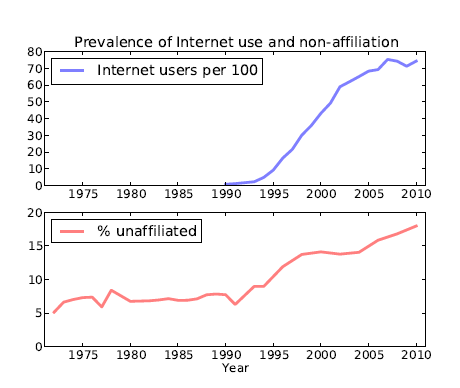Some fascinating data emerged recently which is causing us to re-think a basic assumption about the early history of modern humans and how major changes in technology and political organisation spread. It should also cause creationists to reassess their creation myth if only that were permitted.
It had been assumed that agriculture spread from it's origins somewhere in modern southern Iraq because the idea was obviously so good that it was adopted by neighbouring peoples. In other words, the spread was assumed to be the spread of agricultural cultural rather than a spread of agricultural people.
Now a detailed study of the genomes sequenced from a small number of skeletons of early Stone Age people from Sweden has shown that hunter-gatherers were more genetically distinct from those of early Stone Age farmers from the same area than modern Scandinavians are from Italians. If the spread of agriculture had been cultural we would expect to see no significant difference. The study was conducted on the genomes of four skeletons from Stone Age farming settlements and seven coastal hunter-gatherer communities. Earlier isotope studies on the bones had show distinct differences in diet. It thus seems highly likely that it wasn't so much the idea of agriculture which radiated out from the Middle East, but agricultural people, who replaced the local hunter-gatherers.
So, what we have here is another little conundrum for our creationists friends.
Of course, as you might expect, it's hard to map reality onto their favourite creation myth if only because they don't appear to have allowed for a hunter-gather phase at all. This was very probably because the myth originated in people who were unaware of a hunter-gatherer past so saw no need to mention it, but let's overlook that little problem because, as we will see, there are some much bigger ones for them to worry about.
Then, within no more than six generations when a population of 50-60,000 would have been going some, were able to have a dedicated workforce concentrating on building a tower so high it could reach above the stars and so began to alarm God himself. This could only have been done with a vast agricultural support system to provide the builders and those producing the building materials with enough food and other necessities like clothes and tools without growing it or making them themselves.
This is simple, basic economics, stemming from the simple fact that the same person can't be both building a massive tower and tending to his garden, making things or foraging for food in the surrounding countryside. So, we know the Ark survivors were, or were certainly very soon and within six generations, fantastically productive agriculturalists. (Remember we are still in the creationist fantasy here, not the real world. Any resemblance to reality is purely incidental).
Now, as Pontus Skoglund of Uppsala University in Sweden and his colleagues have shown, a population of hunter-gatherers came from somewhere and spread from the Middle East into Scandinavia in advance of the agriculturalists and they were genetically very distinct from the agriculturalists who followed them. Taken in isolation, this study probably wouldn't mean much and could be explained away as sampling error. However, this is not the first study to reach this conclusion - similar results have been found in Germany and elsewhere.
Abstract
Prehistoric population structure associated with the transition to an agricultural lifestyle in Europe remains contentious. Population-genomic data from eleven Scandinavian Stone-Age human remains suggest that hunter-gatherers had lower genetic diversity than farmers. Despite their close geographical proximity, the genetic differentiation between the two Stone-Age groups was greater than that observed among extant European populations. Additionally, the Scandinavian Neolithic farmers exhibited a greater degree of hunter-gatherer-related admixture than that of the Tyrolean Iceman, who also originated from a farming context. In contrast, Scandinavian hunter-gatherers displayed no significant evidence of introgression from farmers. Our findings suggest that Stone-Age foraging groups were historically in low numbers, likely due to oscillating living conditions or restricted carrying-capacity, and that they were partially incorporated into expanding farming groups.
Skoglund, P., et al; Genomic Diversity and Admixture Differs for Stone-Age Scandinavian Foragers and Farmers
Science 24 April 2014. DOI: 10.1126/science.1253448
The question then is where did these hunter-gatherers come from, and hunter-gatherers moreover that were from a very different genetic line to the agriculturalists who, presumably, were the descendant of Noah and his family? How did this genetic diversity arise so quickly, what with evolution being impossible and no new information being able to arise because it's forbidden by the Second Law of Thermodynamics or Information Theory, or whatever the currently fashionable creationist reason for declaring it impossible is?
Or, if impossible evolution occurred at the warp speed normally offered up to explain this apparent rapid genetic diversity in post-Flood living things, why do we see no transitional forms with genomes intermediate between that of the hunter-gatherers and the subsequent agriculturalists?
And, if we forget for a moment that the Ark survivors must have been agriculturalists already and say some of them must have given rise to the hunter-gatherers while others went of to discover agriculture, there wouldn't have been enough agriculturalists to even consider building that enormous tower, because we would be looking at a local population of a mere few thousand at the most, not nearly enough even to do the building, let alone to sustain an economy capable of supporting such a huge economically non-productive workforce.
I wonder how many creationist can solve this conundrum and how many of those who can't will accept that this little bit of science utterly refutes their biblical creation myth. Anyone prepared to bet that the answers to both these will be as close to zero as makes no difference?















